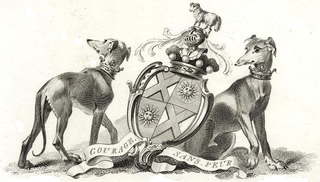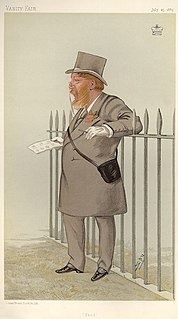
Marquess of Bath is a title in the Peerage of Great Britain. It was created in 1789 for Thomas Thynne, 3rd Viscount Weymouth. The Marquess holds the subsidiary titles Baron Thynne, of Warminster in the County of Wiltshire, and Viscount Weymouth, both created in 1682 in the Peerage of England. He is also a baronet in the Baronetage of England.

Earl of Egmont was a title in the Peerage of Ireland, created in 1733 for John Perceval, 1st Viscount Perceval. It became extinct with the death of the twelfth earl in 2011.

Viscount Gage, of Castle Island in the County of Kerry of the Kingdom of Ireland, is a title in the Peerage of Ireland. It was created in 1720 for Thomas Gage, along with the subsidiary title of Baron Gage, of Castlebar in the County of Mayo, also in the Peerage of Ireland. In 1744 he also succeeded his cousin as eighth Baronet, of Firle Place. The titles remain united. The Gage family descends from John Gage, who was created a baronet, of Firle Place in the County of Sussex, in the Baronetage of England on 26 March 1622. His great-grandson, the seventh Baronet, represented Seaford in Parliament. He was succeeded by his first cousin, Thomas Gage, 1st Viscount Gage, the eighth Baronet. He sat as a Member of Parliament for Minehead and Tewkesbury and also served as Governor of Barbados. In 1720, 24 years before succeeding in the baronetcy, he was raised to the Peerage of Ireland as Baron Gage and Viscount Gage. His second son was the military commander the Hon. Thomas Gage.

Baron Farnham, of Farnham in the County of Cavan, is a title in the Peerage of Ireland. It was created in 1756 for John Maxwell, who had previously represented Cavan Borough in the Irish House of Commons. John Maxwell's son, the second Baron, was created Viscount Farnham in 1760 and Earl of Farnham in 1763. Both titles were in the Peerage of Ireland but became extinct when he died childless in 1779. His brother and successor, the third Baron, was again created Viscount Farnham in 1781 and Earl of Farnham in 1785. These titles were also in the Peerage of Ireland. His son, the second Earl, sat in the House of Lords as an Irish Representative Peer from 1816 to 1823. However, he had no children and on his death in 1823 the viscountcy and earldom became extinct.

Henry Charles Somerset, 6th Duke of Beaufort, KG, styled Marquess of Worcester until 1803, was a British politician.
The Gough-Calthorpe family is descended from ancient and notable families who both held lands in the area around Birmingham, England.
There have been three baronetcies created for members of the Anstruther family, two in the Baronetage of Nova Scotia and one in the Baronetage of Great Britain. Two of the creations are extant while one is extinct.
The Anstruther-Gough-Calthorpe Baronetcy, of Elvetham Hall in Elvetham in the County of Hampshire, is a title in the Baronetage of the United Kingdom.
Sir Charles William Rouse Boughton was an administrator in India with the East India Company and subsequently a member of the British House of Commons representing first Evesham and then Bramber.

Frederick Henry William Gough-Calthorpe, 5th Baron Calthorpe, was a British Liberal Party politician.
Calthorpe is a surname. Notable people with the surname include:

Augustus Gough-Calthorpe, 6th Baron Calthorpe, was a British agriculturist and philanthropist.
Sir Henry Gough, 1st Baronet (1709–1774), also known as Sir Harry Gough, of Edgbaston Hall, Warwickshire, was a British merchant and politician who sat in the House of Commons from 1732 to 1741.
Reynolds Calthorpe of Elvetham in Hampshire was a Whig Member of Parliament for Hindon.
Sir Henry Calthorpe (c.1717–1788) K.B. of Elvetham in Hampshire, was a Member of Parliament for the constituency of Hindon.

Somerset John Gough-Calthorpe, 7th Baron Calthorpe,, was a British soldier and politician.
Henry Gough-Calthorpe, 1st Baron Calthorpe, known until 1796 as Sir Henry Gough, 2nd Baronet, was a British politician who sat in the House of Commons from 1774 to 1796 when he was raised to the peerage.
Lord Alfred Spencer-Churchill DL JP was a British Conservative politician.

Frederick Gough, 4th Baron Calthorpe, known as Hon. Frederick Gough-Calthorpe until 1851, of Elvetham Hall, Hartley Wintney, Hampshire, was a British peer and Member of Parliament.
Sir Francis Salwey Winnington, 5th Baronet DL JP was an English baronet.










